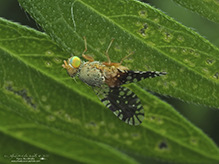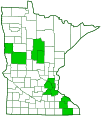common ragweed fruit fly
(Euaresta bella)
Conservation • Description • Habitat • Ecology • Distribution • Taxonomy
|
|
||||||||||||||
Description |
Common ragweed fruit fly is a small fly. It occurs in the United States from Maine to Tennessee, west to North Dakota and eastern Texas, and there are unconnected (disjunct) populations in Florida and Arizona. It occurs in southern Canada from Nova Scotia west to Manitoba. The larvae feed on the fruits of common ragweed (Ambrosia artemisiifolia), the only known host for the species. Adults are active in Minnesota from late June to early September. They are found wherever their host plant grows. Common ragweed fruit fly has been intentionally introduced into parts of Europe as a biocontrol of common ragweed, which is an invasive and troublesome plant in Europe. The plant was accidentally introduced to the Soviet Union in the 1920s. It invades most agricultural crops, and it is difficult to control with chemicals. Adults are small, ⅛″ to 3 ⁄16″ (4 to 5 mm) in length from the antennae to the wingtips. The head is wider than long. The upper part of the front of the head (frons) is wider at the top than the eye, and it has two pairs of bristles. The thorax is dark brown or black, but it is covered with whitish, short, closely matted, woolly hairs, making it appear gray. It has three segments. Each segment has four principal exoskeletal plates, one above, one below, and one on each side. The upper (dorsal) plates, from front to rear, are the prescutum, scutum, and scutellum. The hairs on the scutum and scutellum are swollen. There are two pairs of bristles on the scutellum. The abdomen is reddish brown. The wings are brown to black (dark) in the middle and on the inner margin, with several round, translucent (hyaline) spots of varying sizes. There is a broad, hyaline band around the leading edge and rear margin that is crossed with many thin dark lines radiating to the outer edges. The tip of cell r2+3 has two hyaline spots. The outer end of the subcosta (Sc) vein is bent sharply outward almost at a right angle toward but not quite reaching the vein on the leading edge (costa). The anal cell has a small point at the outer end. It is closed by vein Cu2A, which meets vein Cu1a at an angle less than 90°. The legs are yellow. |
Size |
Total length: ⅛″ to 3 ⁄16″ (4 to 5 mm) |
Similar Species |
Habitat |
Wherever common ragweed (Ambrosia artemisiifolia) is found |
Ecology |
Season |
One generation per year: late June to early September (CCESR) |
Behavior |
|
Life Cycle |
The female lays eggs in the female flowers of common ragweed. The larvae develop in the fruits. They overwinter in the fruits, pupate in the spring, and emerge as adults in early summer. |
Larva Food |
Fruits of common ragweed (Ambrosia artemisiifolia) |
Adult Food |
Ragweed juices, aphid honeydew |
Distribution |
||
|
Sources |
|
| 4/20/2025 | ||
Occurrence |
||
Common |
||
Taxonomy |
|
Order |
|
Suborder |
Brachycera |
Infraorder |
Cyclorrhapha |
Zoosection |
Schizophora |
Zoosubsection |
Acalyptratae |
Superfamily |
Tephritoidea (fruit, signal, and picture-winged flies) |
Family |
Tephritidae (fruit flies) |
Subfamily |
Tephritinae |
Tribe |
Tephritini |
Genus |
Euaresta |
Subordinate Taxa |
|
|
|
Synonyms |
|
Trypeta bella |
|
Common Names |
|
common ragweed fruit fly |
|
Glossary
Costa
On ferns: The central axis of a pinna, to which pinnules are attached. On mosses: the central axis (midvein) of a leaf. On insects: The vein on the leading edge of the forewing.
Frons
The upper front part of an insect’s face, roughly corresponding to the forehead.
Scutellum
The exoskeletal plate covering the rearward (posterior) part of the middle segment of the thorax in some insects. In Coleoptera, Hemiptera, and Homoptera, the dorsal, often triangular plate behind the pronotum and between the bases of the front wings. In Diptera, the exoskeletal plate between the abdomen and the thorax.
Scutum
The forward (anterior) portion of the middle segment of the thorax (mesonotum) in insects and some arachnids.
Visitor Photos |
||
Share your photo of this insect. |
||
This button not working for you? |
||
Alfredo Colon |
 |
MinnesotaSeasons.com Photos |
||
|
||
|
||

Slideshows |
|

Visitor Videos |
||
Share your video of this insect. |
||
This button not working for you? |
||
|
Other Videos |
||
Wild Pollinator Week Spring 2021 - Euaresta bella - Brachyscome multifida |
About
Nov 19, 2021 |
FRUIT FLY Euaresta bella semaphoring with wings |
About
Aug 7, 2019 Euaresta bella FRUIT FLY signaling with wings |

|
Created: 4/20/2025 Last Updated: © MinnesotaSeasons.com. All rights reserved. |


